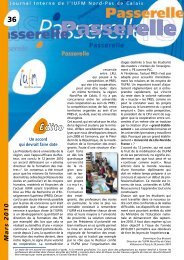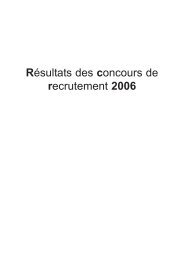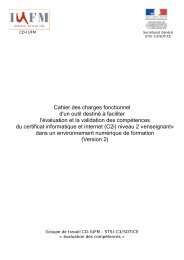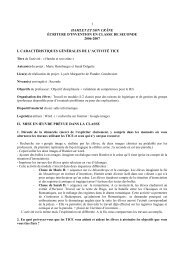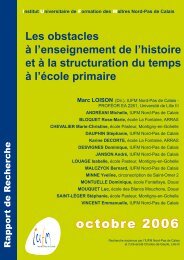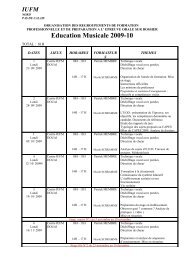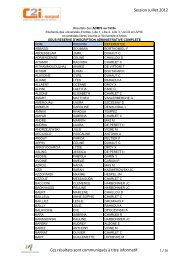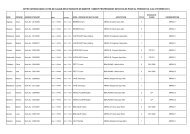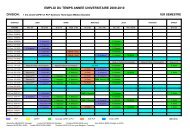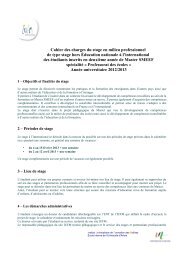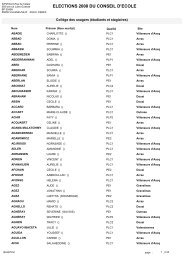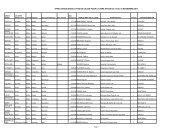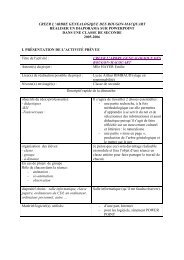Create successful ePaper yourself
Turn your PDF publications into a flip-book with our unique Google optimized e-Paper software.
they think they have <strong>le</strong>arnt in these disciplines throughout the school year.<br />
A student’s answer can be considered as indicators of the way he puts back together the<br />
school discipline referred to and to the way it is organized, throughout his memories of it,<br />
how useful he thinks it is and what definition he gives to the discipline. We therefore consider<br />
it as tracks of what Yves Reuter calls “discipline awareness”.<br />
To understand the graphic we have only kept the characteristics of related answers.<br />
The organization into a hierarchy of the different items shows us how the students deal<br />
with the three different disciplines. They have most troub<strong>le</strong> identifying Analysis whereas<br />
they identify Mathematics and Statistics more c<strong>le</strong>arly. One of the first results of this study is<br />
therefore to show that pupils dealing with closely related fields of know<strong>le</strong>dge, in the same<br />
physical space of the classroom have some troub<strong>le</strong> delimitating the different fields involved.<br />
This result is important for us to know, because in French educational system, even in Junior<br />
High School, it is often the case : students face classes like “Histoire-Géographie” (History-<br />
Geography), “Physique-Chimie” (Physics- Chemistry) etc…<br />
Looking at the graphic (Graph 2) shows that these identifications are interrelated.<br />
(1)”Giving characteristics to an Analysis class” implies “giving characteristics to an<br />
analysis exercise” (85.%)<br />
(2) “Giving characteristics to an Analysis exercise” implies “Giving a list of the<br />
know<strong>le</strong>dge <strong>le</strong>arnt in Analysis class” (90%)<br />
The two combined ru<strong>le</strong>s can be interpreted as the tracks of a comp<strong>le</strong>x network of know<strong>le</strong>dge<br />
which keeps the representations of a specific discipline. They suggest several <strong>le</strong>vels to<br />
these representations of analysis : the highest <strong>le</strong>vel would be determined by the ability to<br />
identify, among what is taught, the discipline’s characteristics.<br />
Other implicative ways are also to be considered<br />
(3) “Giving characteristics to an analysis class” implies “Giving characteristics to a<br />
Mathematics exercise” (85%).<br />
(4) “Giving characteristics to a Mathematics exercise” implies “Giving characteristics<br />
to a Statistics <strong>le</strong>sson” (85%).<br />
The degrees of discipline awareness are therefore probably not independent from one<br />
another : the graph nods in particular (here the identification of an Analysis class specificities)<br />
show the interrelation of these networks.<br />
Lastly, the graphs separation also suggests that factors of disciplines’ identification are<br />
different and not linked. As a matter of fact, one can notice that items in the central graph<br />
send back to everything that has to do with reconstruction within work tasks.<br />
The items on the right end side graphic send back mainly to what has to do with reconstruction<br />
involving other parties, here the teacher.<br />
(5) “To remember a teacher’s presentation of the usefulness of analysis” implies<br />
“Remembering the presentation of analysis usefulness by a teacher” (85%).<br />
This separation among implicative ways and therefore among networks making up the<br />
representations studied here, is interesting.<br />
What seems important here is, outside of the fact that what the teacher says can help define<br />
the disciplines taught, is on the contrary to find out that there is no link between discipline<br />
110<br />
<strong>IUFM</strong> Nord-Pas de Calais




